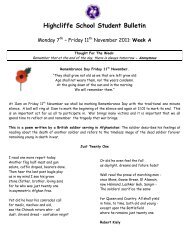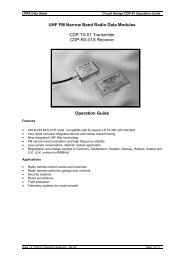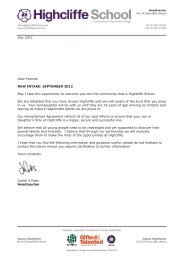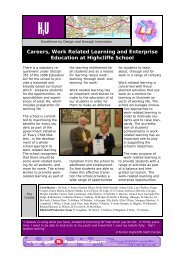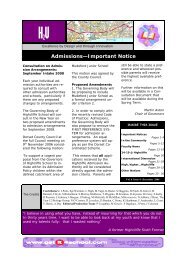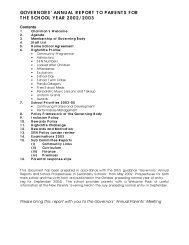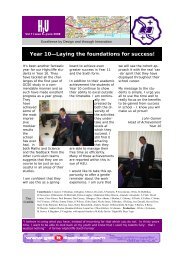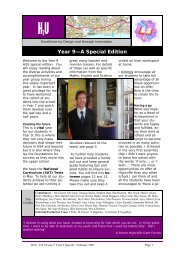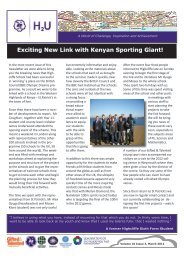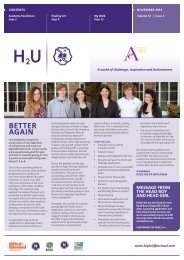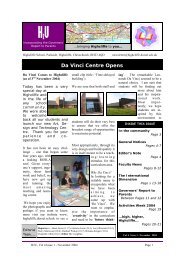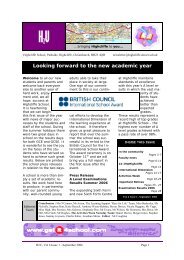Vol 6 Issue 6 March 2007 V2.pub - Highcliffe School
Vol 6 Issue 6 March 2007 V2.pub - Highcliffe School
Vol 6 Issue 6 March 2007 V2.pub - Highcliffe School
You also want an ePaper? Increase the reach of your titles
YUMPU automatically turns print PDFs into web optimized ePapers that Google loves.
Cassie Hearn<br />
The first day, at the library<br />
I arrive at 9am to find the staff drinking coffee; they offer me a drink and then begin to ask me<br />
questions. The staff show me around the library and explain all the different sections and the<br />
methods for the sequence of the books. In the library there are lots of different sections; comics,<br />
novels – such as crime fiction and science fiction. There is also a non-fiction section with autobiographies<br />
and encyclopaedias. On the second floor there are comics, novels, fairy-tales and nonfiction<br />
books for children. At 2pm I arrive back from lunch and go over to the theatre to be shown<br />
around. The theatre is huge and very contemporary; the outside walls are made of glass and inside<br />
there are huge bright orange metal panels. In the theatre there are three main sections of<br />
seating. The stage is very large and above it, we were shown ‘la grille’ where the technicians<br />
control the lighting and the scenery using weights.<br />
The second day of work<br />
I arrive at nine for a coffee and a chat with the staff. Shortly after a group of children from the<br />
primary school arrive. Marie-Pascal (my supervisor) reads the children a book and explains to<br />
them the lay-out of the library and the activity they will be doing that morning. They all form<br />
groups and then go on a treasure hunt to search for certain books! After lunch I go to the museum<br />
to be introduced to my supervisor for the day. Her name is Christine and she is very kind.<br />
We talk for a while about where I am from and my hobbies and I<br />
ask her about her family. Then she shows me the museum, it’s<br />
really interesting. On the ground floor there is a big library full of<br />
ancient books from the 17 th , 18th and 19 th centuries. The books<br />
cover many subjects such as history, medicine, literature etc. On<br />
the book cabinets there are photographs of trees which are a part<br />
of the current exhibition ‘l’arbre’. On the first floor there are lots<br />
of ancient paintings as well as a series of Napoleon’s books. His<br />
books explore his discoveries of plants, animals as well as places.<br />
In the same room, there is also a collection of insects containing<br />
many types of beetles, fossils and ancient artefacts. On the second<br />
floor there are lots of photos these are all for the current exhibition.<br />
The exposition changes every three months and comprises<br />
of lots of photos and explores different photographer’s perceptions<br />
of magnificent trees. In the exposition there are some<br />
old photos from the 1940’s along side some from 2004 this makes<br />
for an interesting comparison and fusion of contemporary and<br />
more traditional art.<br />
The third day of work, at the museum<br />
In the morning Mathilde offers to show me some of the books in the big library downstairs. She<br />
shows me the oldest book in the library which is from 1432; it is preserved in a special paper wallet<br />
as it is no longer bound together. I am also shown books from the 17 th century and the 18 th<br />
century. The French in the 17 th century books is difficult to understand and Mathilde tells me that<br />
people train in 17 th century French in order to understand those<br />
books.<br />
However, the books from the 18 th century are much closer to modern-day<br />
French and therefore more easily understood. After that, I<br />
see the first children’s books from the 19 th century and Mathilde<br />
explains the different types of engraving and how much work<br />
went into the coloured engravings. She also tells me about the<br />
different types of paper and how it has evolved from parchment<br />
(made from goat skin) to paper made from cloth and vegetable<br />
oils and now to modern day paper with water. I found it really interesting to find out about the<br />
progression in coverings, engravings and paper.<br />
The whole experience was really useful and interesting; the people in Pont-Audemer were all<br />
lovely and always willing to help. I would also like to thank Mr Maurice and Mrs Karanja for this<br />
opportunity and all their help.<br />
H2U, <strong>Vol</strong> 6 <strong>Issue</strong> 6 <strong>March</strong> <strong>2007</strong> Page 28



